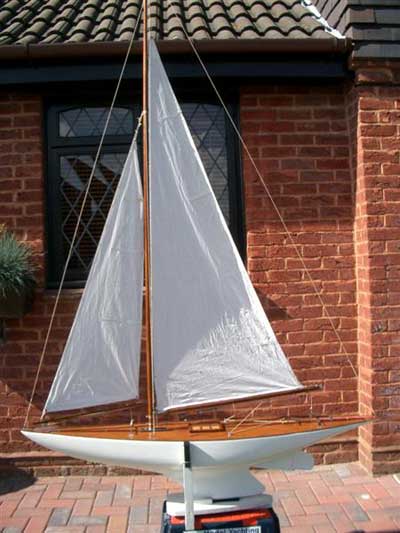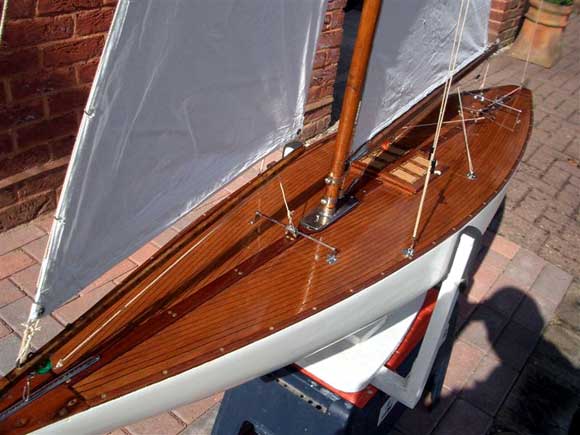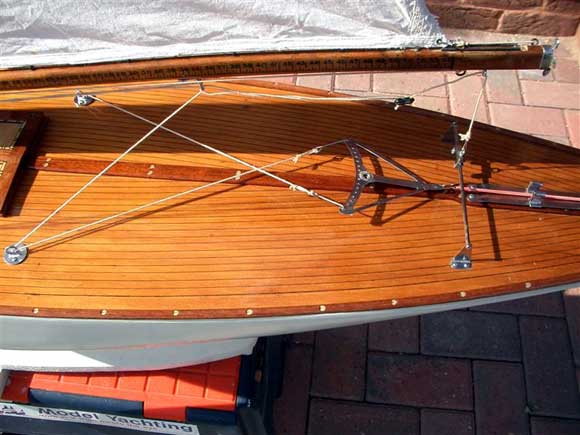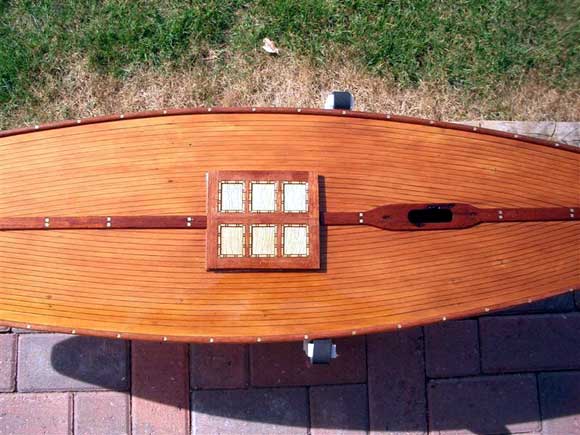
Pic 1: The completely restored 6M yacht confirming the elegance and beauty of this old timer.
The model yacht lakes at Walpole Park, Gosport are synonymous with International A Class Yachts. However, before the introduction of these in 1922, another class was alive and kicking. The 6 Metre Class is basically a scaled down version of a full-size 6 Metre Yacht on a scale of two inches to the foot. This produces a very elegant yacht that is large enough to sail well and is not as large as the A Class, or anywhere near as heavy. Typically the boats are 1400mm long with a draft of 230mm and 0.7 square metres of sail area and a weight of 10kg. Over the years my association with Gosport has encouraged me to salvage old wooden yachts. I use the word salvage, because I am not a restoration fanatic. I like the yachts to look nice, clean and tidy, whilst maintaining their character and to get them back onto the water which is their natural environment and where they should be.
Ravic was brought to my attention by a telephone call early in 2007 from my friend Ray, who on returning from France was clearing out his house prior to moving there permanently. In the loft he rediscovered his father’s yacht. Unfortunately it had been there for over 30 years, not seeing the light of day or any moisture, so that the hull had completely dried out. Ray remembered sailing this with his father on the Canoe Lake at Portsmouth as well as the Gosport lakes. Unfortunately, the main problem was that a careless television aerial man had stood upon the hull, completely crushing the stern and splitting the deck. However, many of the fittings were stored in a separate box. Ravic was built in the 1920s and purchased by Ray’s father from someone in the Portsmouth area just prior to the start of WWII.
Enjoy more Model Boats Magazine reading in the monthly magazine.
Click here to subscribe & save.
Ravic looks the archetypical yacht with the integral fin and ballast, closely followed by a beautiful skeg and rudder. Ray was quite prepared to put Ravic in a skip or take it to the dump, if nothing could be done with the pieces, especially as his own yacht, a half-scale model of Ravic made by his father Vic, was intact and a suitable size for his new home in France.
Restoration
The hull is constructed from mahogany planks, brass nailed to the ribs and as I wrote earlier, had dried out with many seams laughing (opened out). Before commencing work on the hull it was washed down and left with a water filled sponge inside for a few weeks to try and plump up the wood by increasing its moisture content. Having started to remove the paint I thought I was going to end up with a varnished hull, however the cause of the laughing soon became apparent. Poor fitting planks had required considerable filling between them and this had shrunk, so unfortunately the mahogany hull would require a paint finish. The stern section was rebuilt using the stern block as a guide and new planks fitted and filled as required. Several coats of off-white were applied, with fine rubbing down with wet and dry between each coat, to obtain a reasonable finish. A mirror finish was not deemed possible, as some of the nails on the ribs were still just visible. It is important to allow the paint to harden between each coat before continuing the process of building to your final finish. The deck combings had all dried out and split, as had the deck, with the hull spreading causing further damage. A new deck was constructed and lined by permanent pen. The deck was then given a primer coat of diluted yacht varnish to seal it and then several further coats were applied with careful rubbing down between each coat ensuring a splendid finish. New mahogany combings were manufactured, together with a new deck hatch. As part of a signature for my salvage work, I am making hatches in the traditional way in multi-coloured wood, adding banding for effect. Additional fittings to complete the deck hardware were collected from my scrap box, thus completing the hull restoration with period fittings.



Pic 2: The bow and the nicely finished deck. Pic 3: The main boom with index numbering and the Braine steering gear. Pic 4: The neatly restored hatch.
The booms and mast were black with discoloured varnish and this was carefully cleaned off, allowing the colour to show through and the Braine setting numbers to stand out. It was fortunate that these could be retained on both the jib and the main boom. One mainsail was recoverable from the bag of cloth that came with the yacht, once it was washed and ironed. The jib came from my store of old sails, thus providing the yacht with a usable set of genuine vintage cotton sails.
Finally, careful reassembly of all the component rigging parts as seen in the pictures completed the restoration.




